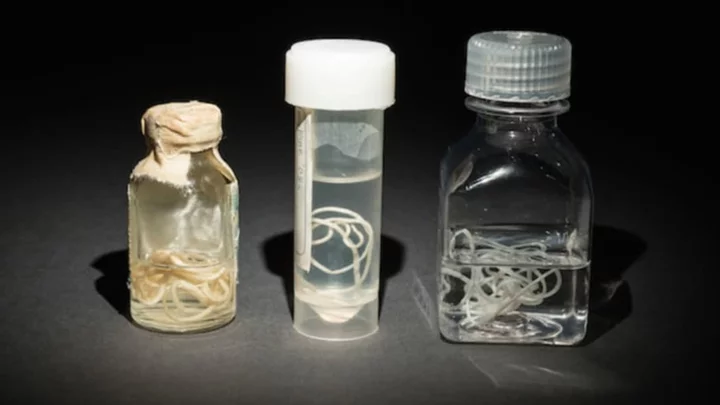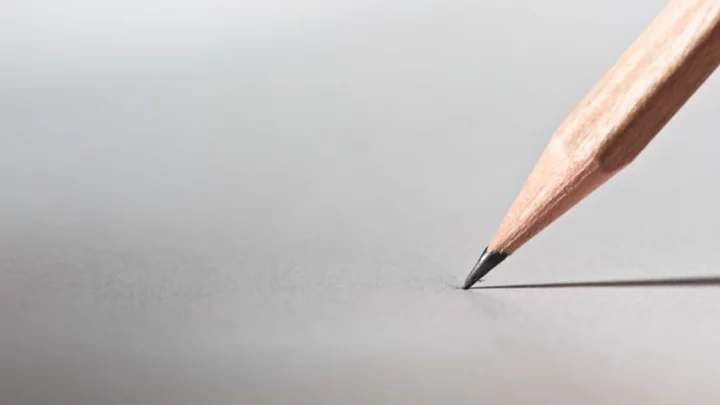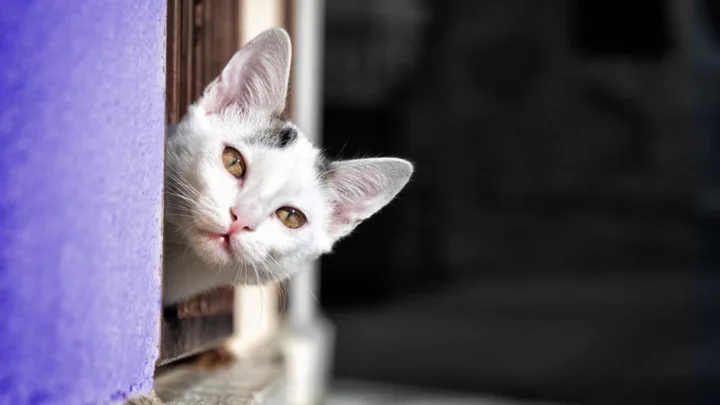Dracunculiasis, or Guinea worm disease is, by all accounts, pretty awful: A person with the disease hosts a parasitic worm that forms a painful blister under the skin that eventually bursts, allowing the worm to emerge and lay its eggs in water. Those afflicted don't just endure pain (although there's plenty of that); they also run the risk of secondary infection and permanent paralysis, and there are economic consequences to the disease, too.
Thankfully, this terrible disease looks to be on its way to eradication. Yesterday, in an event at the American Museum of Natural History in New York City, President Jimmy Carter and the Carter Center announced that there were just 126 cases of Guinea worm disease reported worldwide, a 15 percent decrease from the number of cases reported in 2013. Dracunculiasis stands to be only the second human disease ever eradicated; the first, of course, was smallpox.
“The Carter Center has a basic premise of addressing problems that nobody else wants to take on,” President Carter tells mental_floss. “We found out back in the 1980s that no one wanted to address Guinea worm, because it existed in a bunch of scattered villages in the jungle and the desert that were inaccessible, where people couldn’t read and write ... So we decided to take it on ourselves.”
Visitors to the museum will have the opportunity to learn about Guinea worm and other diseases—including polio, malaria, tuberculosis, and Ebola—in the new exhibition Countdown to Zero: Defeating Disease, created in partnership with the Carter Center. Here are a few new facts we picked up during an early preview and from our chat with President Carter (which you can read in full here).
1. It’s OK if you haven’t heard of Guinea worm disease: It’s an example of what the World Health Organization calls “neglected tropical diseases.” The Carter Foundation targets four other such diseases: schistosomiasis; lymphatic filariasis, or elephantiasis; trachoma; and onchocerciasis, or river blindness. “This year we’ll treat about 25 million people so they won’t go blind from this disease,” President Carter says. “That’s more people than live in the state of New York, as a matter of fact.”
2. Guinea worm disease all starts with stagnant ponds—the only source of drinking water in many affected areas. Tiny crustaceans called copepods that live in the ponds carry Guinea worm larvae (Dracunculus medinensis). When a person drinks water laden with copepods, the Guinea worm larvae emerge and mate in that unlucky person’s abdomen. Then, the female worm migrates to another part of the body (typically the lower limbs), where she’ll sit tight for awhile. Finally, 10 to 14 months after the person has ingested the copepods, a painful blister will form somewhere on their body; under it is a fully grown, up to 3-foot-long parasite "as wide as a cooked spagetti noodle," according to the CDC. In 24 to 72 hours, the blister will burst; usually, an infected person will go back to the pond to soak the blister and relieve the burning; the cold water triggers the worm to emerge from the blister and release eggs into the water, where they’re eaten by copepods—and the cycle starts anew.
3. The disease has been around since ancient times—and so has the typical treatment: wrapping the worm around a stick while slowly extracting it from the body. Some historians think the medical symbol called the Staff of Asclepius was inspired by that particular method of extraction. (Photos of Guinea worm removal are not for the faint of heart; if you're interested, there's a video of the process here, in a profile of the Carter Center's Dr. Donald R. Hopkins.)
4. A calcified Guinea worm was found in a 3000-year-old Egyptian mummy.
5. Getting rid of the copepods that carry Guinea worm larvae is relatively simple: Villagers just have to run their water through a fine nylon filter. Nomads—who can't easily carry large jugs of filtered water—instead use reeds with mesh filters at the ends as straws, which allows them to suck up water from ponds as they move; the Carter Center has distributed 23 million of these pipe filters.
6. Believe it or not, fashion has helped in getting rid of Guinea worm disease. Because the people afflicted with the disease lived in remote areas, they often spoke in native languages and were illiterate, so the Carter Foundation and its partners relied on drawings to get their point across. “We would draw two women side by side: One would be filtering her water, and she would not have Guinea worm; the other woman would not filter her water and she would have Guinea worm,” President Carter says. “Sometimes they’d even print those cartoons up on dresses that they wore and shirts that they gave the men to wear.”
7. In Mali, Dracunculiasis is called “the disease of the empty granary.” Kids who suffer from the disease can’t go to school, and farmers can’t work the fields or tend to their cattle—making the economic consequences of Guinea worm disease disastrous.
8. When the Carter Foundation first decided to tackle Guinea worm disease in 1986, there were an estimated 3.5 million cases annually in 20 countries. Today, Guinea worm affects just 30 villages in four African countries: South Sudan, Chad, Mali, and Ethiopia. “We know every person in the world that has Guinea worm now,” President Carter says. “So we have to monitor villages that didn’t show a case last year and make sure that those cases that we have identified don’t go in the water and spread the disease to future drinkers. So this is what we’re doing now and I don’t think there’s a doubt that in the next two or three years we’ll find the last case.”
9. Still, there are challenges to eradication. “In two countries, Mali and South Sudan, there’s a war going on,” President Carter says. “So sometimes it’s hard to get to the villages in a timely fashion and to find the people who have Guinea worm.” The other issue is nomads, who move from place to place to work seasonal crops. “They spend their lifetime on horseback or camelback, just moving from one place to another,” he says. “So they might drink water in one village and by the time the Guinea worm comes out of their body a year later, they’re 200 miles away in a different place.”
10. “There are smallpox stores in various freezers, and viruses can be frozen and can be used later on to make vaccines, for example,” said AMNH's Mark Siddall, who helped curate the exhibit. “Guinea worm is an animal, it's a nematode worm. Once the last person no longer has any Guinea worm, even if we have Guinea worms in freezers, they're dead—dead dead dead dead dead. They cannot come back.” And, says President Carter, “if people just filtered every drink of water, it would take out the [copepods], and that would mean that there would be no more Guinea worm in that village ever—if everyone was 100 percent following our advice.”
All images courtesy of the American Museum of Natural History and The Carter Foundation.
This article was originally published on www.mentalfloss.com as 10 Facts About Guinea Worm Disease.









